Java中的Map尤其是HashMap我们经常用到,JDK1.8也给HashMap加了不少新特性
Map
三种遍历Map的方法
1. keySet
返回Map中所有Key的Set集合,方法如下:
public Set<K> keySet() {
Set<K> ks = keySet;
if (ks == null) {
ks = new KeySet();
keySet = ks;
}
return ks;
}
keySet内部类:
final class KeySet extends AbstractSet<K> {
public final int size() { return size; }
public final void clear() { HashMap.this.clear(); }
public final Iterator<K> iterator() { return new KeyIterator(); }
public final boolean contains(Object o) { return containsKey(o); }
public final boolean remove(Object key) {
return removeNode(hash(key), key, null, false, true) != null;
}
public final Spliterator<K> spliterator() {
return new KeySpliterator<>(HashMap.this, 0, -1, 0, 0);
}
public final void forEach(Consumer<? super K> action) {
Node<K,V>[] tab;
if (action == null)
throw new NullPointerException();
if (size > 0 && (tab = table) != null) {
int mc = modCount;
for (int i = 0; i < tab.length; ++i) {
for (Node<K,V> e = tab[i]; e != null; e = e.next)
action.accept(e.key);
}
if (modCount != mc)
throw new ConcurrentModificationException();
}
}
}
2. values
返回所有value的集合,方法如下:
public Collection<V> values() {
Collection<V> vs = values;
if (vs == null) {
vs = new Values();
values = vs;
}
return vs;
}
Values内部类:
final class Values extends AbstractCollection<V> {
public final int size() { return size; }
public final void clear() { HashMap.this.clear(); }
public final Iterator<V> iterator() { return new ValueIterator(); }
public final boolean contains(Object o) { return containsValue(o); }
public final Spliterator<V> spliterator() {
return new ValueSpliterator<>(HashMap.this, 0, -1, 0, 0);
}
public final void forEach(Consumer<? super V> action) {
Node<K,V>[] tab;
if (action == null)
throw new NullPointerException();
if (size > 0 && (tab = table) != null) {
int mc = modCount;
for (int i = 0; i < tab.length; ++i) {
for (Node<K,V> e = tab[i]; e != null; e = e.next)
action.accept(e.value);
}
if (modCount != mc)
throw new ConcurrentModificationException();
}
}
}
3. entrySet
返回Entry对象的Set集合,Entry包括Map的key和value,效率比通过keySet获取key再获取value高得多
public Set<Map.Entry<K,V>> entrySet() {
Set<Map.Entry<K,V>> es;
return (es = entrySet) == null ? (entrySet = new EntrySet()) : es;
}
EntrySet内部类:
final class EntrySet extends AbstractSet<Map.Entry<K,V>> {
public final int size() { return size; }
public final void clear() { HashMap.this.clear(); }
public final Iterator<Map.Entry<K,V>> iterator() {
return new EntryIterator();
}
public final boolean contains(Object o) {
if (!(o instanceof Map.Entry))
return false;
Map.Entry<?,?> e = (Map.Entry<?,?>) o;
Object key = e.getKey();
Node<K,V> candidate = getNode(hash(key), key);
return candidate != null && candidate.equals(e);
}
public final boolean remove(Object o) {
if (o instanceof Map.Entry) {
Map.Entry<?,?> e = (Map.Entry<?,?>) o;
Object key = e.getKey();
Object value = e.getValue();
return removeNode(hash(key), key, value, true, true) != null;
}
return false;
}
public final Spliterator<Map.Entry<K,V>> spliterator() {
return new EntrySpliterator<>(HashMap.this, 0, -1, 0, 0);
}
public final void forEach(Consumer<? super Map.Entry<K,V>> action) {
Node<K,V>[] tab;
if (action == null)
throw new NullPointerException();
if (size > 0 && (tab = table) != null) {
int mc = modCount;
for (int i = 0; i < tab.length; ++i) {
for (Node<K,V> e = tab[i]; e != null; e = e.next)
action.accept(e);
}
if (modCount != mc)
throw new ConcurrentModificationException();
}
}
}
1. HashMap
-
以散列表(哈希表)的形式存储,无序
-
非线程安全,任意时刻可以有多个线程同时读取HashMap,可能会导致数据的不一致
需要考虑线程安全的,考虑使用ConcurrentHashMap,尽量避免使用旧类HashTable
-
扩容比较耗费性能,因此初始化一个HashMap的时候尽量给定大小
HashMap的扩容是新建一个2^n大小的哈希表数组,移动旧
-
相比于JDK1.7,JDK1.8的新特性:
- Node实现了Map.Entry接口
- 扩容方式有了以下几个有点:
- 不需要重新计算hash值
- 转移的链表相对顺序不会改变
- 在并发扩容中不会出现死锁
- hash值取模运算之前加入了高位运算
- 链表元素超过8个的时候采用红黑树方式存储
HashMap存储
哈希表+链表+红黑树
哈希数组存放每个链表的头结点

红黑树TreeNode:
static final class TreeNode<K,V> extends LinkedHashMap.Entry<K,V> {
TreeNode<K,V> parent; // red-black tree links
TreeNode<K,V> left;
TreeNode<K,V> right;
TreeNode<K,V> prev; // needed to unlink next upon deletion
boolean red;
}
数组table用于存放元素:
transient Node<K,V>[] table;
Entry内部类、节点内部类定义:
hashmap实际上就是一个Entry数组
static class Node<K,V> implements Map.Entry<K,V> {
final int hash;
final K key;
V value;
Node<K,V> next;
Node(int hash, K key, V value, Node<K,V> next) {
this.hash = hash;
this.key = key;
this.value = value;
this.next = next;
}
}
HashMap Hash计算
static final int hash(Object key) { int h; return (key == null) ? 0 : (h = key.hashCode()) ^ (h >>> 16);}
假如table表的长度为16(默认值),那么此表此时采用的hash值位数为4
-
调用hashCode取得hash值
此时key通过调用hashCode生成一个32位的hash值
-
hash值进行高位运算(JDK1.8新特性)
>>>16: 无符号右移,向右边移动16位,高位由0补充
^ : 异或运算符,相同为0,相反为1,此时hash值变成16位
进行高位运算,是为了减少运算,特别是在数组长度较小的情况下,高位也参与了运算
自己的高位与低位做异或运算,是为了混合高位和低位,以此来加大低位的随机性,混合后的地位也保留了高位的信息。
-
hash值对数组长度进行取模运算
16位的hash值与数组长度(4位)进行与运算,此时hash值变成4位

HashMap 扩容
JDK1.7的扩容方式
- 扩容后,链表的顺序变成逆序
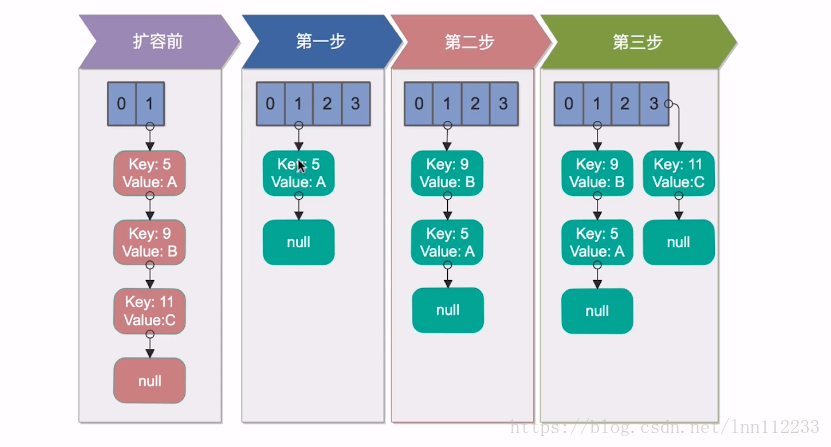
1.7扩容源代码:
void resize(int newCapacity) {
Entry[] oldTable = table;
int oldCapacity = oldTable.length;
// 当前数据长度已经达到最大容量
if (oldCapacity == MAXIMUM_CAPACITY) {
threshold = Integer.MAX_VALUE;
return;
}
// 创建新的数组
Entry[] newTable = new Entry[newCapacity];
boolean oldAltHashing = useAltHashing;
useAltHashing |= sun.misc.VM.isBooted() &&
(newCapacity >= Holder.ALTERNATIVE_HASHING_THRESHOLD);
// 是否需要重新计算hash值
boolean rehash = oldAltHashing ^ useAltHashing;
// table数据转移到新的table
// 可能导致死锁
transfer(newTable, rehash);
// 数组重新赋值
table = newTable;
// 重新计算阈值
threshold = (int)Math.min(newCapacity * loadFactor, MAXIMUM_CAPACITY + 1);
}
transf
55 void transfer(Entry[] newTable, boolean rehash) {
56 int newCapacity = newTable.length;
57 for (Entry<K,V> e : table) {
58 while(null != e) {
// 提前保存下一次循环需要的链表节点
59 Entry<K,V> next = e.next;
60 if (rehash) {
61 e.hash = null == e.key ? 0 : hash(e.key);
62 }
// 新表的插入位置
63 int i = indexFor(e.hash, newCapacity);
// 新表可能有元素,将e.next指向新表头部
64 e.next = newTable[i];
65 newTable[i] = e;
// 继续循环
66 e = next;
67 }
68 }
69 }
在JDK1.7中,扩容可能会发生死锁:
若线程一正在扩容,刚刚建立好新的哈希表,正在移动链表,其中e指向A,e.next指向B
此时线程二开始,put一个新值,发现 空间不够,也执行扩容操作
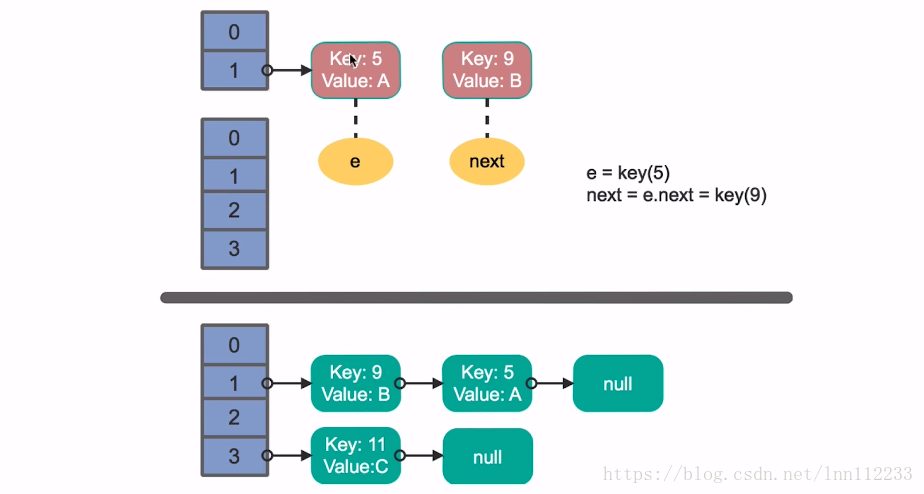
线程二完成扩容并put后,线程一继续扩容,由于e指向A,所以指向A到新table,随后更新e,e指向e.next即B,e.next指向null:
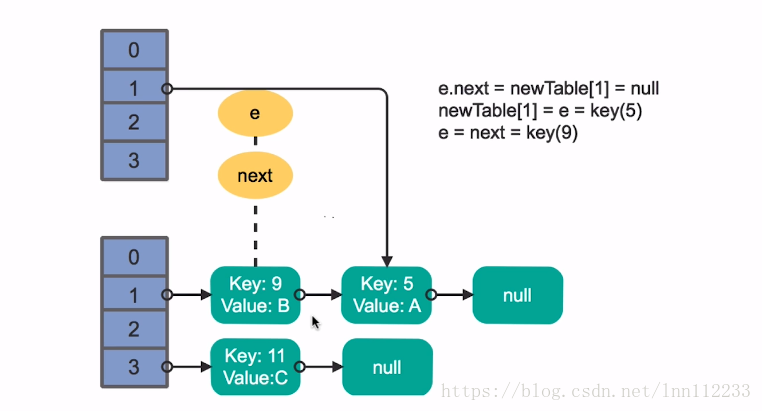
由于e指向B,所以指向B到新table,随后更新e,e指向e.next即null,e.next也指向null:
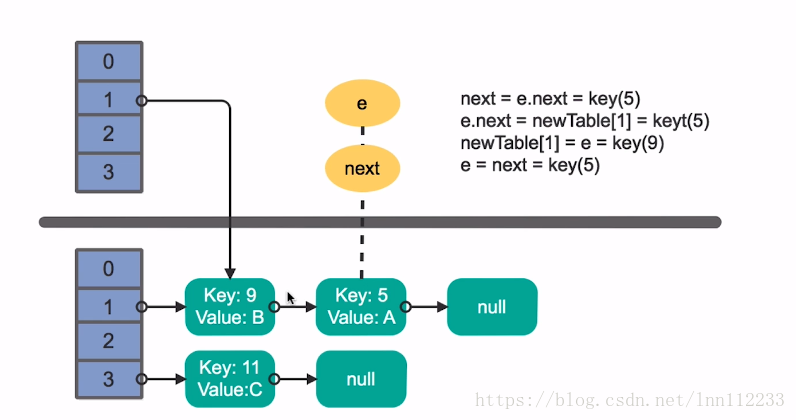
此时线程一结束,不过相当于进行了两次移动,由 1 -> A -> B ->null 变成 1 -> B -> A -> null 又变成 1 -> A -> B -> null,在第一次移动(线程二)建立了B-A的指向,在第二次移动(线程一)又建立了A-B 的指向,A与B之间出现了死锁。
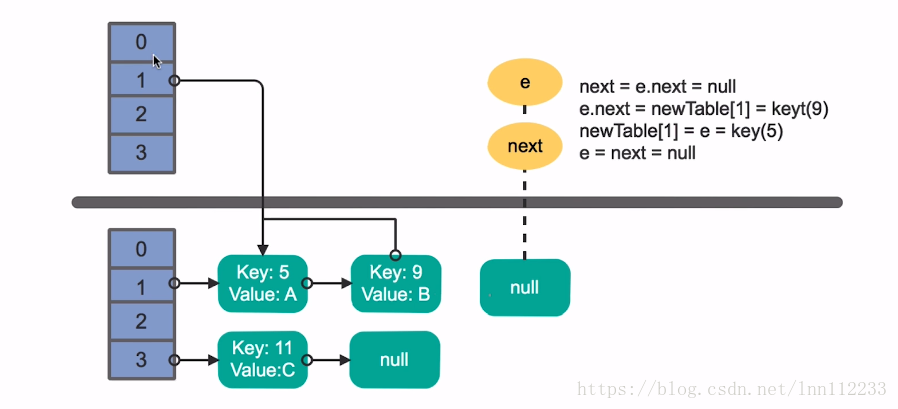
JDK1.8的扩容方式
1.8扩容源代码:
final Node<K,V>[] resize() {
Node<K,V>[] oldTab = table;
// 旧数组的 size 容量
int oldCap = (oldTab == null) ? 0 : oldTab.length;
// 旧的 阈值
int oldThr = threshold;
// 新的容量和阈值
int newCap, newThr = 0;
if (oldCap > 0) {
// 如果 容量 大于最大容量 1<<30,阈值就等于 Int 的最大值 即 不再扩容
if (oldCap >= MAXIMUM_CAPACITY) {
threshold = Integer.MAX_VALUE;
return oldTab;
}
// 两个过程
// 1. 设置新的容量 : newCap(新的容量) = oldCap(旧容量) * 2 扩大为原来的2倍
// 2. 设置新的阈值 : 如果 newCap(新的容量) 小于 最大值 并且 旧容量 大于 默认的容量值 , 新的阈值设为 旧的阈值的2倍
else if ((newCap = oldCap << 1) < MAXIMUM_CAPACITY &&
oldCap >= DEFAULT_INITIAL_CAPACITY)
newThr = oldThr << 1; // double threshold
}
// 如果旧表的长度的是0,就是说第一次初始化表
// 如果旧的阈值 大于 0 , 新的容量 = 旧的阈值
else if (oldThr > 0) // initial capacity was placed in threshold
newCap = oldThr;
// 表示 旧表 容量 和 阈值 都等于 0 ,表示 从来没有初始化过
else { // zero initial threshold signifies using defaults
// 赋值个默认值
newCap = DEFAULT_INITIAL_CAPACITY;
newThr = (int)(DEFAULT_LOAD_FACTOR * DEFAULT_INITIAL_CAPACITY);
}
// 如果新的阈值 等于 0 ,按阈值计算公式(size*加载因子)进行计算
if (newThr == 0) {
float ft = (float)newCap * loadFactor;
newThr = (newCap < MAXIMUM_CAPACITY && ft < (float)MAXIMUM_CAPACITY ?
(int)ft : Integer.MAX_VALUE);
}
// 给全局的 threshold 阈值 赋值
threshold = newThr;
@SuppressWarnings({"rawtypes","unchecked"})
// 创建新的 数组
Node<K,V>[] newTab = (Node<K,V>[])new Node[newCap];
// 赋值给全局的 table
table = newTab;
// 把旧的数组中的值, 按某种规则 迁移 到新的数组中
if (oldTab != null) {
//遍历桶数组,并将键值对映射到新的数组中
for (int j = 0; j < oldCap; ++j) {
Node<K,V> e;
if ((e = oldTab[j]) != null) {
//置为null, 方便进行GC
oldTab[j] = null;
if (e.next == null)
//说明这个node中没有链表,直接放在新表的e.hash & (newCap - 1)位置
newTab[e.hash & (newCap - 1)] = e;
else if (e instanceof TreeNode)
// 如果 此节点是 红黑树(也就是说有冲突), 采用红黑树管理冲突的键值对
((TreeNode<K,V>)e).split(this, newTab, j, oldCap);
else { // preserve order
// 证明此节点是 链表 的形式解决冲突的
//新表是旧表的两倍容量,实例上就把单链表拆分为两队,
//e.hash&oldCap为偶数是低队,e.hash&oldCap为奇数的是高队
Node<K,V> loHead = null, loTail = null;
Node<K,V> hiHead = null, hiTail = null;
Node<K,V> next;
do {
next = e.next;
// 低队
if ((e.hash & oldCap) == 0) {
if (loTail == null)
loHead = e;
else
loTail.next = e;
loTail = e;
}
// 高队
else {
if (hiTail == null)
hiHead = e;
else
hiTail.next = e;
hiTail = e;
}
} while ((e = next) != null);
if (loTail != null) {
//低队不为null,放在新表原位置
loTail.next = null;
newTab[j] = loHead;
}
if (hiTail != null) {
//高队不为null,放在新表 j + oldCap 的位置
hiTail.next = null;
newTab[j + oldCap] = hiHead;
}
}
}
}
}
return newTab;
}
HashMap get方法
传入key值,返回value
根据key的hash值进行取模运算作为table下标来获取key在table中对应的Node节点串
由于hash值分布问题,一个Node节点可能有一串的node节点,就需要判断对应node节点的hash值是否一致,否则继续向所在Node节点串的下一个节点查找
public V get(Object key) {
Node<K,V> e;
return (e = getNode(hash(key), key)) == null ? null : e.value;
}
final Node<K,V> getNode(int hash, Object key) {
Node<K,V>[] tab; Node<K,V> first, e; int n; K k;
// 是否存在符合条件的node串
if ((tab = table) != null && (n = tab.length) > 0 &&
(first = tab[(n - 1) & hash]) != null) {
// node串的头节点是否是要找的node
if (first.hash == hash && // always check first node
((k = first.key) == key || (key != null && key.equals(k))))
return first;
if ((e = first.next) != null) {
if (first instanceof TreeNode)
return ((TreeNode<K,V>)first).getTreeNode(hash, key);
// 在node串中循环查找对应的node
do {
if (e.hash == hash &&
((k = e.key) == key || (key != null && key.equals(k))))
return e;
} while ((e = e.next) != null);
}
}
return null;
}
HashMap put方法
传入key,value,返回旧值或者null
先查询table中key对应的hash值取模运算后的位置有没有node,如果没有就新建一个,如果有就在node串后面添加一个
public V put(K key, V value) {
return putVal(hash(key), key, value, false, true);
}
// onlyIfAbsent: true的话不修改原来的值,false的话更新原来的值
final V putVal(int hash, K key, V value, boolean onlyIfAbsent,
boolean evict) {
Node<K,V>[] tab; Node<K,V> p; int n, i;
if ((tab = table) == null || (n = tab.length) == 0)
n = (tab = resize()).length;
// 找不到对应的node串,新建node串
if ((p = tab[i = (n - 1) & hash]) == null)
tab[i] = newNode(hash, key, value, null);
else {
Node<K,V> e; K k;
// 判断node串的头节点是否是需要更新的node
if (p.hash == hash &&
((k = p.key) == key || (key != null && key.equals(k))))
e = p;
else if (p instanceof TreeNode)
e = ((TreeNode<K,V>)p).putTreeVal(this, tab, hash, key, value);
else {
// 循环node串
for (int binCount = 0; ; ++binCount) {
// 循环所有都没找到对应node,新建node
if ((e = p.next) == null) {
p.next = newNode(hash, key, value, null);
if (binCount >= TREEIFY_THRESHOLD - 1) // -1 for 1st
treeifyBin(tab, hash);
break;
}
// 存在相同的key值,break
if (e.hash == hash &&
((k = e.key) == key || (key != null && key.equals(k))))
break;
p = e;
}
}
// 已存在key值
if (e != null) { // existing mapping for key
V oldValue = e.value;
if (!onlyIfAbsent || oldValue == null)
e.value = value;
afterNodeAccess(e);
return oldValue;
}
}
++modCount;
if (++size > threshold)
resize();
afterNodeInsertion(evict);
return null;
}
2. LinkedHashMap
-
LinkedHashMap有顺序,通过iterator遍历的时候是按照插入的顺序遍历的
- 继承了HashMap,比HashMap多了head、tail链表
- 非线程安全
transient LinkedHashMap.Entry<K,V> head;
transient LinkedHashMap.Entry<K,V> tail;
3. TreeMap
- 具有排序的功能,通过iterator遍历的时候默认按照key值的升序遍历
- 非线程安全
TreeMap存储方式
红黑树:
static final class Entry<K,V> implements Map.Entry<K,V> {
K key;
V value;
Entry<K,V> left;
Entry<K,V> right;
Entry<K,V> parent;
boolean color = BLACK;
}
4. WeakHashMap
- 弱键映射,映射之外无引用的键,会被垃圾回收
- 非线程安全